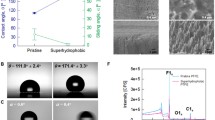Abstract
Superhydrophobic surfaces have been widely applied to solve environmental issues using their many functions such as drag reduction, oil–water separation and self-cleaning. It is well known that superhydrophobicity of materials can be enhanced by imparting micro/nano hierarchical patterns on its surface. Although several techniques, such as MEMS, coating, and laser ablation, have been suggested to improve superhydrophobicity, they are unsuitable for mass production. To overcome this limitation, a facile fabrication method using hot imprinting process was developed in this study. Hierarchical patterns including micro sinusoidal patterns with discharge craters were formed on the die surface obtained using wire electrical discharge machining. Thermoplastic PTFE and PC polymer surfaces with hierarchical patterns were successfully replicated from the die surface after hot imprinting. In addition, an entangled micro fibril network was observed on the PTFE surface, whereas torn shapes were developed on the PC polymer surface. As a result, the polymer surfaces were found to exhibit superhydrophobicity with a water contact angle > 150°.













Similar content being viewed by others
References
Lee, H. J., & Park, K. (2014). Development of composite micro-patterns on polymer film using repetitive ultrasonic imprinting. Int J Precis Eng Manuf-Green Technol,1(4), 341–345.
Lee, S. H., Lee, J. H., Park, C. W., Lee, C. Y., Kim, K., Tahk, D., et al. (2014). Continuous fabrication of bio-inspired water collecting surface via roll-type photolithography. Int J Precis Eng Manuf-Green Technol,1(2), 119–124.
Kwon, M. H., Jee, W. Y., & Chu, C. N. (2015). Fabrication of hydrophobic surfaces using copper electrodeposition and oxidation. Int J Precis Eng Manuf,16(5), 877–882.
Barthwal, S., Kim, Y. S., & Lim, S. H. (2012). Superhydrophobic and superoleophobic copper plate fabrication using alkaline solution assisted surface oxidation methods. Int J Precis Eng Manuf,13(8), 1311–1315.
Chun, D. M., Davaasuren, G., Ngo, C. V., Kim, C. S., Lee, G. Y., & Ahn, S. H. (2014). Fabrication of transparent superhydrophobic surface on thermoplastic polymer using laser beam machining and compression molding for mass production. CIRP Ann,63(1), 525–528.
Bae, W. G., Kim, D., Song, K. Y., Jeong, H. E., & Chu, C. N. (2015). Engineering stainless steel surface via wire electrical discharge machining for controlling the wettability. Surf Coat Technol,275, 316–323.
Liu, W., Sun, L., Luo, Y., Wu, R., Jiang, H., Chen, Y., et al. (2013). Facile transition from hydrophilicity to superhydrophilicity and superhydrophobicity on aluminum alloy surface by simple acid etching and polymer coating. Appl Surf Sci,280, 193–200.
Jiang, D., Fan, P., Gong, D., Long, J., Zhang, H., & Zhong, M. (2016). High-temperature imprinting and superhydrophobicity of micro/nano surface structures on metals using molds fabricated by ultrafast laser ablation. J Mater Process Technol,236, 56–63.
Zhan, Y. L., Ruan, M., Li, W., Li, H., Hu, L. Y., Ma, F. M., et al. (2017). Fabrication of anisotropic PTFE superhydrophobic surfaces using laser microprocessing and their self-cleaning and anti-icing behavior. Colloids Surf Physicochem Eng Asp,535, 8–15.
Zhang, Y. Y., Ge, Q., Yang, L. L., Shi, X. J., Li, J. J., Yang, D. Q., et al. (2015). Durable superhydrophobic PTFE films through the introduction of micro-and nanostructured pores. Appl Surf Sci,339, 151–157.
Toma, M., Loget, G., & Corn, R. M. (2014). Flexible teflon nanocone array surfaces with tunable superhydrophobicity for self-cleaning and aqueous droplet patterning. ACS Appl Mater Interfaces,6(14), 11110–11117.
Cho, Y. H., Seo, Y. S., Moon, I. Y., Kim, B. H., & Park, K. (2013). Facile fabrication of superhydrophobic poly (methyl methacrylate) substrates using ultrasonic imprinting. J Micromech Microeng,23(5), 055019.
Jucius, D., Grigaliūnas, V., Mikolajūnas, M., Guobienė, A., Kopustinskas, V., Gudonytė, A., et al. (2011). Hot embossing of PTFE: towards superhydrophobic surfaces. Appl Surf Sci,257(6), 2353–2360.
Wang, X. C., Wu, L. Y., Shao, Q., & Zheng, H. Y. (2009). Laser micro structuring on a Si substrate for improving surface hydrophobicity. J Micromech Microeng,19(8), 085025.
Schmid, G., Levering, M., & Sawitowski, T. (2007). Nanostructured surfaces of metals and polymers by imprinting with nanoporous alumina. Z Anorg Allg Chem,633(13), 2147–2153.
Bae, W. G., Song, K. Y., Rahmawan, Y., Chu, C. N., Kim, D., Chung, D. K., et al. (2012). One-step process for superhydrophobic metallic surfaces by wire electrical discharge machining. ACS Appl Mater Interfaces,4(7), 3685–3691.
Cassie, A. B. D., & Baxter, S. (1944). Wettability of porous surfaces. Trans Faraday Soc,40, 546–551.
Wenzel, R. N. (1936). Resistance of solid surfaces to wetting by water. Ind Eng Chem,28(8), 988–994.
Zhang, J., Li, J., & Han, Y. (2014). Superhydrophobic PTFE surfaces by extension. Macromol Rapid Commun,25(11), 1105–1108.
Brown, E. N., & Dattelbaum, D. M. (2005). The role of crystalline phase on fracture and microstructure evolution of polytetrafluoroethylene (PTFE). Polymer,46(9), 3056–3068.
Rae, P. J., & Brown, E. N. (2005). The properties of poly (tetrafluoroethylene)(PTFE) in tension. Polymer,46, 8128–8140.
Acknowledgements
The authors thank for support from the Basic Research Program of the Korea Institute of Materials Science.
Author information
Authors and Affiliations
Corresponding author
Additional information
Publisher's Note
Springer Nature remains neutral with regard to jurisdictional claims in published maps and institutional affiliations.
Rights and permissions
About this article
Cite this article
Moon, I.Y., Kim, B.H., Lee, H.W. et al. Superhydrophobic Polymer Surface with Hierarchical Patterns Fabricated in Hot Imprinting Process. Int. J. of Precis. Eng. and Manuf.-Green Tech. 7, 493–503 (2020). https://doi.org/10.1007/s40684-019-00094-5
Received:
Revised:
Accepted:
Published:
Issue Date:
DOI: https://doi.org/10.1007/s40684-019-00094-5




